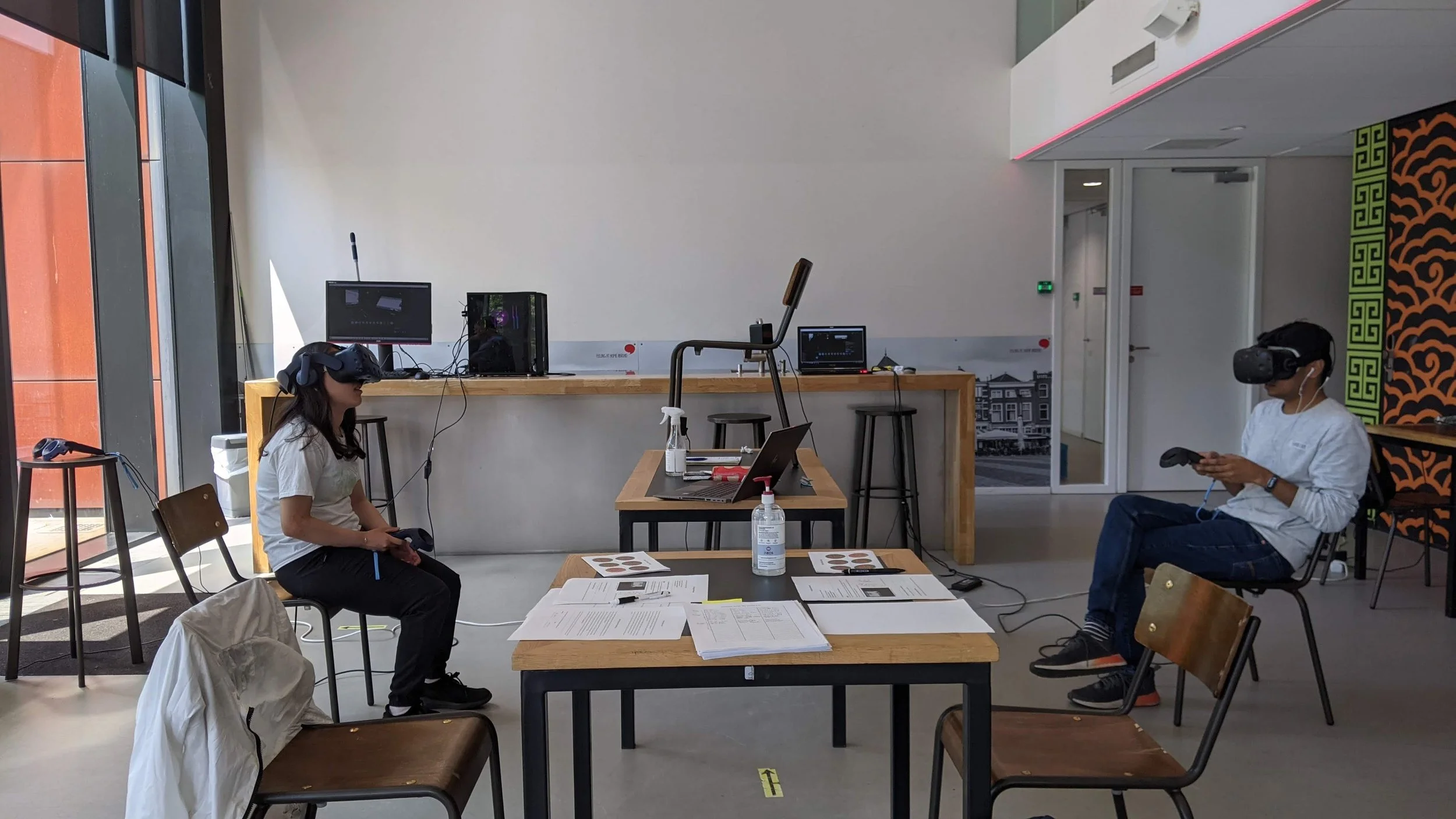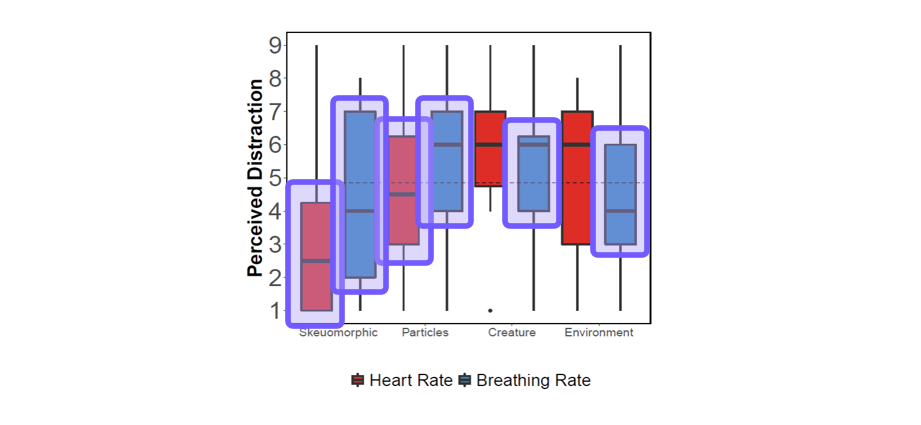Understanding and Designing Biosignal Visualizations for Social VR Entertainment
Presented at:
CHI 2022 Paper, April 29 - May 5th, 2022
Dutch Post-CHI 2022, Jun 22nd, 2022
Master’s Thesis, August 2021
Summary
Visualizing biosignals can be important for social Virtual Reality (VR), where avatar non-verbal cues are missing.
We adopt a mixed-methods approach to design biosignals for social VR entertainment. Using survey, context-mapping, and co-design methods, we derive four visualizations.
We then ran a within-subjects study in a virtual jazz bar to investigate how heart rate (HR) and breathing rate (BR) visualizations, and signal rate, influence perceived avatar arousal, user distraction, and preferences.
Keywords
Biosignals, social VR, visualization, entertainment, virtual reality, perception, design
Skills
Unity3D (C#), Blender, SteamVR, Python, Survey, Interview, Co-design session, Mixed-method research, Miro
Researchers
Sueyoon Lee, Abdallah Ei Ali, Maarten Wijntjes, Pablo Cesar
Biosignals and Social VR
Biosignals are all kinds of signals that can be measured and monitored from biological beings, such as heart rate, breathing rate. Researchers have shown that displaying those “expressive” biosignals as a social cue has the potential to enhance interpersonal communication.
Social VR is a type of VR environment, where users can meet and interact with their virtual representations in a shared immersive environment. In social VR, avatars can map user’s real movements, and also sometimes show believable facial expressions.
Heart rate visualizations in smartwatch
Goal
Several researchers have explored visualizing biosignals of avatars in VR so that can enhance user’s immersion within the VR spaces; however, it remains unclear:
What are the user’s perceptions of biosignals and avatar representations in social VR?
How to design interpretable and non-distracting visualizations?
Are those visualizations effective (in an entertainment scenario)?
Understanding User’s Perception
We conducted a survey and context mapping interviews to understand the current user’s perception. We asked users to prefill the workbook and conducted interviews based on that, to gather deeper insights.
After analysis, we acquired 3 findings, 5 themes on users' attitudes, and 7 aspects to be considered for visualizing biosignals.
Workbook example completed by a participant (Miro)
Visualizing Biosignals in Social VR
Based on our understanding of user perception, we moved to start visualizing biosignals. We narrowed down our focus to social VR entertainment settings, such as watching movies or attending live music events.
We conducted a co-design session with 6 designers to brainstorm the ways to visualize heart rate, breathing rate, and EDA(electrodermal activity), in social VR entertainment settings. Designers were guided to use the 7 considerations, which were derived from the previous research when brainstorming their ideas.
Co-design session board
Ideation template
The 2 hours of co-design session resulted in 6 ways of visualizing biosignals.
Prototype
We selected a virtual jazz bar as a use case, as the user’s perception is highly dependent on the environmental conditions, and its nature is suitable for sharing biosignals.
Six visualization ideas were developed into four VR visualization prototypes for the final controlled study. The final biosignal visualizations and jazz bar environment were built using Unity and Blender.
Jazz bar design top view
Final visualization prototypes in jazz bar
Finding the Most Suitable Visualizations
We planned a within-subject designed experiment, comparing 4 visualizations (skeuomorphic, particles, creature, and environment), 2 biosignal types (heart rate and breathing rate), and 3 biosignal rates (low, rest, and high).
The first part was a quantitative experiment where we presented Likert-scale questions to rate their experience within VR. The second part was a qualitative experiment where we interviewed participants about their experience with VR.
Independent variables
Experiment setup
Quantitative (Left), Qualitative (Right)
Analysis
Quantitative: We figured that skeuomorphic visualizations for both heart rate and breathing rate allow differentiable arousal inference. Skeuomorphic and Particles were the least distracting visualization for heart rate; however, all the visualizations were similarly distracting for breathing rate.
Qualitative: From the interview, we found that the Skeuomorphic design was most intuitive and minimally distracting, whereas Particles gives an overall atmospheric feeling but some found it as confusing. The creature was too cute and had distracting nature, and was also regarded as a separate identity instead of being connected to the avatar. Environment one was suitable for atmospheric mood, and its peripheral aspect was highlighted.
Perceived avatar arousal
Perceived avatar distraction
Interview results on the visualizations
Conclusion
I would like to conclude by sharing some design considerations for future studies (Fig 17). Please read the paper to find out the detailed user-centric design process and also deeper insights and statistical analysis.
Fig 17. Some design considerations
Teaser Video
Presentation Video
Reference
Sueyoon Lee, Abdallah El Ali, Maarten Wijntjes, and Pablo Cesar. 2022. Understanding and Designing Avatar Biosignal Visualizations for Social Virtual Reality Entertainment. In Proceedings of the 2022 CHI Conference on Human Factors in Computing Systems (CHI '22). Association for Computing Machinery, New York, NY, USA, Article 425, 1–15. https://doi.org/10.1145/3491102.3517451














